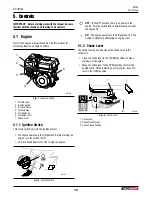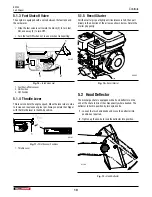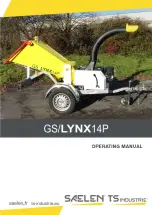
Service and Maintenance
BXC34
Cart Chipper
32
7.5 Drive Belt Replacement
The clutch on the engine shaft has an internal brake. When
engaged, it brakes the engine pulley to stop the belt dive and
rotor plate pulley. When the belt is in disrepair or loose, the
ability to stop the rotor quickly may be affected. It is important
to periodically check belt tension and condition.
Frayed,
cracked or worn drive belts should be replaced.
IMPORTANT! If changing or removing drive belt, always set
correct belt tension. Make sure engine and rotor sheaves
align properly.
Check drive belt tension every 100 hours of operation.
Make sure the engine is off and components are cool to touch
beforehand.
1.
Remove the drive belt shield.
2.
Loosen the four bolts (1) that hold the engine mount to the
main frame.
3.
Turn the belt tensioning bolt (2) counterclockwise to loosen
the belt. Slide the engine back and remove the belt.
01194
1
2
Fig. 31 –
Engine Mount
1. Engine Mount Bolts
2. Belt Tension Adjuster
4.
Install the new belt, slide the engine forward, and set
correct drive belt tension. See
Tensioning Drive Belt
to
follow.
IMPORTANT! Check sheave alignment after changing the
drive belt.
7.5.1 Drive Belt, Tensioning
Drive belt deflection should be no more than 1/4"–3/8"
(6 mm–10 mm).
For accurate measurement use a drive belt tension gauge. If one
is not available, the following method can be used.
1.
Push on the drive belt by hand to check its deflection.
Correct belt deflection is 1/4"–3/8" (6 mm–10 mm).
01195
1/4"–3/8"
(6 mm–10 mm)
Fig. 32 –
Checking Drive Belt Tension
2.
If the belt requires adjustment, loosen (do not remove) the
four bolts that hold the engine mount to the main frame.













































